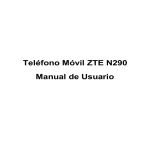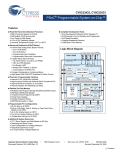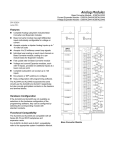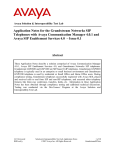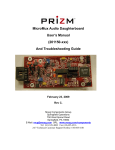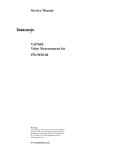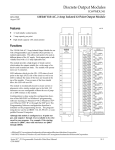Download to IC697ALG320 PDF for more information.
Transcript
This Datasheet for the IC697ALG320 Analog Input, Voltage/Current, 8 Channels. http://www.qualitrol.com/shop/p-14748-ic697alg230.aspx Provides the wiring diagrams and installation guidelines for this GE Series 90-30 module. For further information, please contact Qualitrol Technical Support at 1-800-784-9385 [email protected] 1 Analog Modules IC697ALG320 58 GFK-0388G August 1997 High Level Analog Output System - Voltage/Current Module High Level Analog Output System - Voltage/Current Module (IC697ALG320) datasheet GFK-0388G Features D High Level Analog voltage and current outputs on one module D Output module has four outputs individually configurable for voltage or current D Provides unipolar or bipolar Analog voltage outputs up to Ç 10 volts full scale D D D D D Provides 0 to 22.5 milliamp current loop signals Individual user scaling on each output channel Fast update rate a44034 OK OK 1 3 1I CHANNEL 1 4 GND 6 N.C. 8 + 10 7 I 11 2I 12 2V 13 CHANNEL 2 GND 14 N.C. 16 + 18 15 GND 17 I 19 3I 20 3V 21 GND 22 N.C. 24 CHANNEL 3 23 GND 25 + I 26 27 4I Analog outputs use %AQ references in the PLC. A maximum of 8K words of %AQ memory is available in the PLC. Each output channel uses one word (16 bits) of %AQ memory. GND 9 Functions The basic converter is 16 bits resolution (1 part in 65536) with 14-bit monotonicity. Outputs are isolated from the backplane and are protected against transient and steady-state overvoltage conditions. 1V 5 Calibrated at factory with factory calibration data stored in non-volatile EEPROM memory The high level Analog Output system for the Programmable Logic Controller (PLC) accepts digital data from the CPU or other controllers accessing the PLC backplane. This output data is converted by a Digital to Analog (D/A) converter to analog outputs of up to 10 volts full scale, or 0 to 22.5 milliamp current loop signals. I 2 + No jumpers or DIP switches for user to configure Easy configuration using the configuration function of the MS-DOSr or Windowsrprogramming software running on Windowsr 95 or Windows NTr over Ethernet TCP/IP or through the SNP port. The Programming Software configuration function is installed on the programming device. The programming device can be an IBMr XT, AT,PS/2r or compatible Personal Computer. OUTPUT ANALOG (V&I) OUTPUT ANALOG (V&I) HIGH LEVEL 28 4V 29 CHANNEL 4 SLOT GND 30 N.C. 32 31 GND 33 N.C. V 34 USER 35 N.C. COM 36 COM 38 GND 40 37 COM 39 GND MODULE IC697ALG320 LABEL 44A726758–020R02 Figure 1. High Level Analog Output Module r IBM and PS/2 are registered trademarks of International Business Machines Corporation. r MS-DOS, Windows, Windows 95, and Windows NT are registered trademarks of Microsoft Corporation. t Series 90 -70 Programmable Controller Data Sheet Manual GFK-0600F 58-1 Analog Modules 2 GFK-0388G August 1997 High Level Analog Output System - Voltage/Current Module System Operation A block diagram of the IC697ALG320 High Level Analog Output module and an example of user field wiring connections to the module are shown below. Î Î Î ÎÎ Î ÎÎÎ ÎÎÎÎ Î ÎÎÎ Î Î ÎÎÎ VOUT VOLTAGE OUTPUT a43970 10V VLOAD VRET CH 1 GND JUMPER FOR OUTPUT REF PLC BACKPLANE OPTO– ISOLATION D V OUT A 4–20MA LOAD RET GND VC VOUT VOLTAGE OUTPUT VRET CH 2 GND REF V OUT RET GND PWR + USER POWER SUPPLY PWR .001 VCM 10K GND MODULE GROUND USER GROUND Figure 2. Block Diagram and User Wiring Information for IC697ALG320 Connections for both voltage and current loads are shown in the above illustration. Note the following regarding the illustration: 1. Each output may be configured for either voltage or current - not both. 2. If used as a current output you must jumper VOUT to IREF. 58-2 3. Power for the voltage output is derived from the PLC backplane. Power for the 4 to 20 mA current output must be supplied by the user. A single connection (PSPOS and PSNEG) serves all four channels. t Series 90 -70 Programmable Controller Data Sheet Manual GFK-0600F Analog Modules 3 GFK-0388G August 1997 High Level Analog Output System - Voltage/Current Module Channel-to-Channel Compliance User Wiring Connections While it is expected that output loads will be floating or tied to the same potential (normally ground), the module is designed to allow up to 0.5 VDC compliance voltage (labeled VC in the previous illustration) difference between outputs and still operate within specifications. This prevents ground loop currents or errors from occurring due to small differences in ground potential at different locations. Note that in addition to this offset, outputs will operate properly in the presence of a large amount of high frequency noise (refer to specifications). As shown in the previous illustration. the output circuitry is isolated from the PLC backplane. This allows the module to operate within specifications with a common mode voltage of up to Ç 60V from ground (shown as VCM in the illustration). It must be observed, however that the entire output section of the module (all four channels) operates at a singleoffset voltage from ground potential. Common mode voltage between outputs must be within the specifications stated in the previous paragraph. Figure 4 shows the wiring assignments for the screw terminals on the terminal board on the Analog Output module. In addition to the information in this data sheet, circuit wiring diagrams are printed on the inside surface of the label inserted in the module’s hinged door. OUTPUT ANALOG ( V & IOUT + 1I 2 3 4 I RET GND GND + 2I I RET GND I OUT 11 12 GND + 3I GND GND GND 16 I REF 18 19 + a43972 + 4I I RET V RET 22 GND GND 24 25 I REF 27 VOUT 26 4V 28 V RET 29 GND GND 30 22 PWR 19.2 V USER COM 36 PWR COM 38 GND GND 40 14 12 10 600 800 R L Figure 3. User Power vs. Load Impedance Series 90 -70 Programmable Controller Data Sheet Manual GFK-0600F GND 33 N.C. 35 N.C. 37 COM PWR 39 GND GND GND 34 MIN 16 31 32 24 PWR VOUT 3V 23 N.C. N.C. t V RET 21 GND V OUT 14 MAX 400 + 2V 20 I RET 26 200 I REF 10 17 28.8 18 GND GND 8 13 I OUT 20 VRET 9 I OUT V OUT 6 7 N.C. N.C. This module will accommodate a wide range of load impedance; up to 800 ohms. The range of allowable power supply voltage for a given load impedance is shown in Figure 3. For example, a 24V Ç 20% supply (19.2 to 28.8 volts) will provide sufficient power with loads from 200 to 550 ohms. 28 + 1V 5 User Power for Current Loops 30 I REF 1 15 V (USER POWER SUPPLY) a43973 ) MODULE IC697ALG320 Figure 4. Field Wiring Connections to Module’s I/O Terminal Board 58-3 Analog Modules 4 GFK-0388G August 1997 High Level Analog Output System - Voltage/Current Module Connections to User Devices Connections to the Analog Output module from user devices are made to screw terminals on a removable 40-terminal connector block mounted on the front of the module. All field connections to the outputs should be wired to the I/O terminal board using a good grade of twisted, shielded instrumentation cable. Separate connections are provided on the terminal board for both current outputs and voltage outputs for each channel. Actual terminals used are determined by the configuration that has been selected for each individual channel. Ground connections for each channel, labeled GND, on the terminal board are provided for connecting VOLTAGE: V OUT + V shields. This ground connection is made directly to the rack, resulting in superior rejection of noise caused by any shield drain currents. Actual selection of ground location may be influenced by system power and ground considerations. However, best operation will be obtained when system ground is physically close to the rack containing the analog circuits. Normally, the shield is grounded at only one end (see Figure 5). For additional system grounding information refer to the discussion on system grounding in chapter 3 of the Programmable Controller Installation Manual. The module provides electrical isolation of externally generated noise between the output field wiring and the backplane through use of optical isolation. Î Î REF OUT USER DEVICE V OUT V RET GND a43974 CURRENT: Î RET Î V RET NC GND SHIELD CONNECTED AT MODULE END ONLY Î Î Î Î Î Î USER DEVICE SHIELD CONNECTED AT MODULE END ONLY Figure 5. Cable Connections to Field Devices 58-4 t Series 90 -70 Programmable Controller Data Sheet Manual GFK-0600F Analog Modules 5 GFK-0388G August 1997 High Level Analog Output System - Voltage/Current Module Recommended Field Wiring Procedures The following procedures are recommended when connecting field wiring to the detachable terminal board on the Analog Output module. Module features referenced in the following procedures which are common to all IC697 I/O modules are illustrated in the following figure. a43855 JACKSCREW HINGED DOOR TERMINAL BOARD CORD TIE ÎÎ ÎÎ CORD TIE CLEAT ÎÎ ÎÎ ÎÎÎÎ ÎÎÎÎ ÎÎÎÎ ÎÎÎÎ ÎÎÎÎ ÎÎÎÎ ÎÎÎÎ ÎÎÎÎ ÎÎÎÎ ÎÎÎÎ ÎÎÎÎ ÎÎÎÎ Î Î ÎÎÎÎ Î Î JACKSCREW Î CORD TIE CLEAT CORD TIE STRAP CLEAT Î Î Î Î STRAP STRAP Figure 6. I/O Module Common Features 1. Turn off power before removing or installing terminal boards. Open the hinged door on the module to access a jackscrew which holds the terminal board securely in place. The Detachable field wiring terminal board can now be removed from the module by turning the jackscrew counter-clockwise until it is fully disengaged. 2. To remove the terminal board, grasp the top of the terminal board and swing it outward. Caution Do not use the hinged door to remove the terminal board. The hinged door could be damaged if this is done. t Series 90 -70 Programmable Controller Data Sheet Manual GFK-0600F 3. The terminal board is designed to accept wire sizes from AWG #22 (0.36 mm2) through AWG #14 (2.10 mm2). It is important that when using AWG #14 (2.10 mm2) wire for wiring all points, that a maximum insulation diameter of .135 inch (3.43 mm) not be exceeded. To ensure proper connection, two wires may be terminated on any one terminal only if both wires are the same size. 4. The terminal board is designed to accept a maximum of (40) AWG #14 (2.10 mm2)wires. If AWG #14 (2.10 mm2) wires are to be used, then wire markers should be placed at least 8 inches (203 mm) from termination end to provide sufficient space for the hinged door to close. 58-5 Analog Modules 6 GFK-0388G August 1997 High Level Analog Output System - Voltage/Current Module ÎÎÎ ÎÎ ÎÎÎ ÎÎ ÎÎÎ Î ÎÎ ÎÎÎ Î ÎÎ ÎÎÎ ÎÎÎ ÎÎÎ ÎÎ Î ÎÎÎ Î ÎÎÎ ÎÎ Î ÎÎ ÎÎÎ ÎÎÎ Î ÎÎ Î JACKSCREW a43747 ÎÎ ÎÎ ÎÎ ÎÎÎÎÎÎÎ ÎÎ Î ÎÎ Î ÎÎÎÎÎ ÎÎÎÎÎ DO NOT PULL ON DOOR WIRE BUNDLE CABLE TIE CLEAT Figure 7. Removal of I/O Terminal Board 5. After completing connections to all modules in a rack, the wire bundle must be secured. To ensure that the wire bundle is secured properly, it is recommended that a cable tie be wrapped around the wire bundle and tightly secured through the cable tie cleat located at the lower right corner of the terminal board. For extremely large wire bundles, additional cable ties should be used. only secures the terminal board to the rack, it also provides a way of identifying the wired terminal board with its correct mating rack slot location. 8. For adequate module ventilation, it is recommended that at least a 5 inch (127 mm) clearance be allowed above and below the rack grill. Wire bundles should not obstruct the rack grill work. 6. A door label insert is included with each module to indicate circuit wiring information and provide space to record user circuit wiring identification. A slot is provided on the hinged door to allow for insertion of this label. If the label is difficult to insert, crease the scored edge before insertion. The outside label has a color coded stripe to allow quick identification of the module voltage type (blue: low voltage; red: high voltage). Removing an I/O Module 7. After field wiring is completed, the terminal board should be securely fastened to the rack by inserting the terminal board strap (attached to each module) into the small rectangular slots in the bottom card guide grill on the rack. This strap not 58-6 The instructions below should be followed when removing an I/O module from its slot in a rack. D Grasp the board firmly at the top and bottom of the board cover with your thumbs on the front of the cover and your fingers on the plastic clips on the back of the cover. D Squeeze the rack clips on the back of the cover with your fingers to disengage the clip from the rack rail and pull the board firmly to remove it from the backplane connector. D Slide the board along the card guide and remove it from the rack. t Series 90 -70 Programmable Controller Data Sheet Manual GFK-0600F Analog Modules 7 GFK-0388G August 1997 High Level Analog Output System - Voltage/Current Module Module/R ack Configuration configuring the slot to accept only identical module types. A high level analog output system for the programmable controller can consist of multiple Analog Output modules providing up to a maximum of 252 output channels. If it is necessary to change the module location in the rack after the key has been latched onto the center rail of the rack, the key can be removed by pushing it upward to unhook the latch while pushing it off the rail. It may then be reinserted into the rack at the desired location. A maximum of seven Analog Output modules can be installed in a CPU rack, and a maximum of eight Analog Output modules can be installed in an expansion rack. Channel numbers for each Analog Output module in a system are assigned by the system. ÎÎ ÎÎ ÎÎ ÎÎ ÎÎ ÎÎ ÎÎ ÎÎ ÎÎ Î ÎÎ ÎÎ ÎÎ ÎÎ ÎÎ ÎÎ ÎÎ ÎÎ ÎÎ Î * * * * * * * ÎÎ ÎÎ ÎÎ ÎÎ ÎÎ ÎÎ ÎÎ ÎÎ ÎÎ Î ÎÎ ÎÎ ÎÎ ÎÎ ÎÎ ÎÎ ÎÎ ÎÎ Î ÎÎÎ Î ÎÎ ÎÎ ÎÎ ÎÎ ÎÎ ÎÎ ÎÎ ÎÎ ÎÎ Î ÎÎ ÎÎ ÎÎ ÎÎ ÎÎ ÎÎ ÎÎ ÎÎ ÎÎ Î ÎÎÎÎÎÎÎÎÎÎÎÎÎÎÎÎÎÎÎ MAIN RACK P S a43975 C B P T U M 7 EXPANSION RACKS (MAXIMUM) Configurable Functions You can configure certain functions through the MS-DOS or Windows software configurator function using the programming computer. These functions include output ranges, user scaling, and fault reporting. Each of these functions and their definitions are listed in Table 1. ANALOG OUTPUT * MODULES CAN BE INSTALLED IN ANY OF THESE SLOTS ÎÎ ÎÎ ÎÎ ÎÎ ÎÎ ÎÎ ÎÎ ÎÎ ÎÎ Î ÎÎ ÎÎ ÎÎ ÎÎ ÎÎ ÎÎ ÎÎ ÎÎ ÎÎ Î ÎÎ ÎÎ ÎÎ ÎÎ * ÎÎ * *ÎÎ *ÎÎ *ÎÎ *ÎÎ *Î ÎÎÎÎÎÎÎÎÎÎÎÎÎÎÎÎÎ* Î ÎÎÎ ÎÎ ÎÎ ÎÎ ÎÎ ÎÎ ÎÎ ÎÎ ÎÎ Î ÎÎÎ Î ÎÎÎÎÎÎÎÎÎÎÎÎÎÎÎÎÎÎÎ ÎÎ ÎÎ ÎÎ ÎÎ ÎÎ ÎÎ ÎÎ ÎÎ ÎÎ Î ÎÎÎÎÎÎÎÎÎÎÎÎÎÎÎÎÎÎÎ EXPANSION RACK B R M Figure 8. Example of Analog Output Module Installation Module Mechanical Keying Each module includes a mechanical key that prevents inadvertent substitution of one module type for another in a given slot. The key fits a uniquely shaped area on the board below the connector. When the module is first installed, the key latches onto the backplane center rail. When the module is extracted, the key remains in the center rail, thereby t Note that in an IC697CHS PLC rack only the power supply can be placed in the leftmost slot in the rack, and slot 1 (adjacent to the power supply) must always contain a CPU (in rack 0 - the CPU rack), or a Bus Receiver Module or Remote I/O Scanner (in expansion racks). Series 90 -70 Programmable Controller Data Sheet Manual GFK-0600F Module Configuration Data After the CPU has been updated, the Analog Output module is ready for configuration data. The CPU provides the following module configuration data D The output circuit type (voltage or current) for each output channel D CPU fault reporting interrupt, whether enabled or disabled on a per channel D The default value for outputs and whether outputs are enabled or disabled on system failure or CPU command Each of the output channel values is checked for overrange, underrange, and open wire; open wire only if configured for current range. Note For more detailed information on using the configuration function, refer to the Programming Software User’s Manual. 58-7 Analog Modules 8 GFK-0388G August 1997 High Level Analog Output System - Voltage/Current Module Table 1. Configurable features for IC697ALG320 Feature Channel or Module Selections Default Setting –10V, +10V 0V, +10V Voltage/Current Channel –5V, +5V –10V, +10V 0V, +5V 4, 20 mA Report Faults Channel Scaling Points Channel User Value mV or mA Enabled/Disabled Enabled Ç 32767 µA +20000, –4000 µA Ç 10000 mV +10000 mV, –10000 mV Output Default Channel Hold/Off Off Default Value Channel Ç 32767 0 Output Ranges For each output circuit, the range selected during configuration should match the signal. The 4 to 20 milliamp range can be used for current output devices. For current loop operation, the terminal board jumper for each applicable channel must be installed (refer to Figure 4, Field Wiring Connections to I/O Terminal Board). Output Default Output Default mode is activated when the CPU output data is not being received, such as during powerup, when the CPU is stopped, or CPU communications have been lost. When this occurs, each channel can be configured to Hold Last State or default to a configured Default Value. If configured to Hold Last State, the channel will maintain the last output value received from the CPU until communications resume. If Output Default is configured to OFF, the configured Default Value is applied. Note that the data available to the outputs will be different according to where the system is in relation to time (starting at power-up). This time vs. output data relationship is shown below (Figure 9). Default Value If the Output Default is set to OFF, this value, programmed in Engineering Units, is applied to the output until communications are restored. CONDITION POWER UP OUTPUTS AT 0 CONFIGURATION RECEIVED FROM CPU (CPU STOPPED) CPU RUNNING (I/O SCAN) OUTPUTS AT DEFAULT VALUE (EVEN WITH HOLD LAST STATE ACTIVE) OUTPUTS AT LAST SCAN VALUE SYSTEM FAILURE OR PLC SOFTWARE RESET HOLD LAST STATE OR DEFAULT (USER CONFIG) STATE a43977 CPU STOP OUTPUTS AT LAST SCAN VALUE Figure 9. Time vs. Output Data Relationship 58-8 t Series 90 -70 Programmable Controller Data Sheet Manual GFK-0600F Analog Modules 9 GFK-0388G August 1997 High Level Analog Output System - Voltage/Current Module software configurator function. Scaling is set by entering the desired voltage or current value and the corresponding engineering units for each of two points. Engineering units are a 16-bit signed value (–32767 to +32767). When configuring scale factors, 0 mV or 0 mA must correspond to an engineering unit number between +32767 and –32767. User Scaling User scaling is definable on a per circuit basis on the Analog Output module. The scaling feature allows the user to convert the value in engineering units into millivolts or milliamps as required by the output device being controlled. Engineering units provide measurement that relates to the application, such as, pressure (psi), speed (feet per second), or temperature (degrees F, C, or K). The default configuration for channels configured for voltage, as shown in Figure 10, provides values of –32000 to +32000 corresponding to a voltage output range of –10 to +10 volts. If a channel is configured for current, default scaling is 0 to 32000 for a current range of 4 to 20 mA (see Figure 11). Note Scaling to engineering units does not increase the resolution of the value, but does transform it into more convenient units. Scaling can be used to compensate for differences between actual and theoretical values due to inaccuracies encountered in field devices. Scaling can be configured by the user on a per channel basis with the MS-DOS or Windows programming a44136 POINT 32000, 10000 OUTPUT VOLTAGE 10000MV 32000 5000MV 30000 POINT (16000,5000) USER SCALING 10000 0 10000 30000 32000 5000MV 10000MV POINT 32000, 10000 Figure 10. User Scaling for Voltage Output t Series 90 -70 Programmable Controller Data Sheet Manual GFK-0600F 58-9 Analog Modules 10 GFK-0388G August 1997 High Level Analog Output System - Voltage/Current Module POINT 1 32000, 20000 OUTPUT CURRENT a44137 20000 µ A (16000, 12000) 16000 µ A 12000 µ A 8000 µ A 30000 POINT 2 (0, 4000) 4000 µ A 10000 0 8000 10000 4000 µ A USER SCALING 30000 8000 µ A 12000 µ A 16000 µ A 20000 µ A Figure 11. User Scaling for Current Output Using Data Commands to Modify Configuration The Data Command provides a mechanism that allows you to modify some of the diagnostic configuration parameters of the Analog Output Module from ladder logic. The Data Command uses the COMMREQ function block and a small block of parameters to update certain configuration parameters on the fly. memory before it is executed. It should then be executed by a by a one-shot to prevent sending the data to the module multiple times. Successive COMMREQs must be separated by at least 1 millisecond to guarantee correct processing. A description of the COMMREQ function and its command block data follows, along with a ladder example which uses registers %R0001 to %R0008 for the COMMREQ command block. Refer to the applicable Programmable Controller Reference Manual for additional specific information on COMMREQs. Sending Data Commands Using the COMMREQ Function COMMREQ Function Block Description The PLC ladder program sends a Data Command using the COMMREQ (Communication Request) function. The COMMREQ requires that all its command data be placed in the correct order in the CPU The Communications Request (COMMREQ) function is a conditionally executed function that communicates a particular request, through the ladder logic program, to the Analog module. 58-10 t Series 90 -70 Programmable Controller Data Sheet Manual GFK-0600F Analog Modules 11 GFK-0388G August 1997 High Level Analog Output System - Voltage/Current Module Communications Request Function Block Format The ladder logic representation of the COMMREQ function block is as follows: %Q0200 +——————+ —] [———(enable)+ COMM_+—(ok)— | REQ | %Q0201 %R0001——+IN FT+——————————————( )—— | | CONST ——+ SYSID| 0107 | | | | CONST ——+ TASK | 00001 | | +——————+ The Communications Request function block has four inputs and two outputs. The first input is an enable input. Generally a one-shot coil is used to enable the COMMREQ function. This prevents multiple messages from being sent. The second input (IN) is the starting location of the COMMREQ command block. The SYSID input is used to indicate which rack and slot to send the message to (physical location of Analog module). The last input (TASK) is set to the channel number to be configured. In the above example, channel 1 of rack 1, slot 7 will be configured and the COMMREQ command block starts at Register 0001. Power is always passed to the ok output. The fault output (FT) is enabled if the COMMREQ fails. Command Block The command block for Data Commands is made up of eight words (all values in hexadecimal unless otherwise indicated). Use the block move command to move these values to the Register tables (refer to the applicable Programmable Controller Reference Manual, for information on using the block move function). Table 2. Command Block for Data Commands Location Data Description %R0001 0002 Length of data is two words %R0002 0000 Not used (Always zero) %R0003 0000 Not used %R0004 0000 Not used %R0005 0000 Not used %R0006 0000 Not used %R0007 nnnn Data Command - Command Word - Word 0 %R0008 nnnn Data Command - Command Word - Word 1 Analog Output Data Command Parameters The Data Command can be used to change the configuration of Fault Reporting and Output Default values for each channel. Each Data Command reconfigures both of the parameters for the specified channel using the new data. Bits in the configuration word are numbered with bit 1 being the least significant bit. Table 3. Analog Output Data Command Parameters ÁÁÁÁÁÁÁÁÁÁÁÁÁÁÁÁÁÁÁÁÁÁÁÁÁÁÁÁ ÁÁÁÁÁÁÁÁ ÁÁÁÁÁÁÁÁ ÁÁÁÁÁÁÁÁÁÁÁÁ ÁÁÁÁÁÁÁÁ ÁÁÁÁÁÁÁÁ ÁÁÁÁÁÁÁÁÁÁÁÁ ÁÁÁÁÁÁÁÁÁÁÁÁÁÁÁÁ ÁÁÁÁÁÁÁÁÁÁÁÁ ÁÁÁÁÁÁÁÁÁÁÁÁÁÁÁÁÁÁÁÁ ÁÁÁÁÁÁÁÁ ÁÁÁÁÁÁÁÁÁÁÁÁÁÁÁÁÁÁÁÁÁÁÁÁÁÁÁÁ Location Description Command Word 0 Configuration Word Data Bit 5: Bit 8: Command Word 1 t Output Default Value Series 90 -70 Programmable Controller Data Sheet Manual GFK-0600F 0 - Default Outputs 1 - Hold Last State 0 - Fault Report Enabled 1 - Fault Report Disabled Range Ç 32767 Engineering Units 58-11 Analog Modules 12 GFK-0388G August 1997 High Level Analog Output System - Voltage/Current Module Example - Sending Data Commands An example of ladder logic for sending a data command to an Analog Output module using COMMREQ function blocks is shown below. In this example, the COMMREQ command block is located in registers %R0001 through %R0008. The command to send the data is initiated by the conditional input %I0289 which sets output %Q0200 for one sweep. The Analog Output module is located in Rack 1, slot 7 (first expansion rack). This command will disable fault re- porting, and set the high and low alarm thresholds to +20000 and –20000, respectively. If the COMMREQ command data is formatted incorrectly, or has an invalid command, the Analog Output module will set the Error Status %I bit, and return an error code in Module Status Code %AQ word. Note that the comments within /* . . . . */ have been included for information purposes only. They are not generated by the programming software. | |%I0289 %Q0200 +–—] [————————————————————————————————————————————————————————————(P)—— | |%I0290 %Q0201 +——] [————————————————————————————————————————————————————————————(P)—— | |%Q0200 +—————+ +——] [———+BLKMV+— /* Move Command block into Registers 1—7 */ | | WORD| | | | | CONST —+IN1 Q+—%R0001 /* Command block data starts at %R0001 */ | 0002 | | /* Command data length is 2 words */ | | | /* | CONST —+IN2 | | 0000 | | /* Not used (always 0000) */ | | | | CONST —+IN3 | | 0000 | | /* Not used (always 0000) */ | | | | CONST —+IN4 | | 0000 | | /* Not used (always 0000) */ | | | | CONST —+IN5 | | 0000 | | /* Not used (always 0000) */ | | | | CONST —+IN6 | | 0000 | | /* Not used (always 0000) */ | | | | CONST —+IN7 | | 0080 +—————+ /* First word (Command Word) */ | /* In this case, disable fault reporting */ | /* and default outputs */ 58-12 t Series 90 -70 Programmable Controller Data Sheet Manual GFK-0600F Analog Modules High Level Analog Output System - Voltage/Current Module 13 GFK-0388G August 1997 | | |%Q0200 +—————+ +——] [———+BLKMV+— /* Move data into registers 8 through 14 */ | |WORD | | | | | CONST —+IN1 Q+—%R0008 | 4E20 | | /* Register 8 sets the Output Default Value */ | | | /* to 20000 (Hexadecimal 4E20) */ | CONST —+IN2 | | 0000 | | /* Remaining registers are not used */ | | | | CONST —+IN3 | | 0000 | | | | | | CONST —+IN4 | | 0000 | | | | | | CONST —+IN5 | | 0000 | | | | | | CONST —+IN6 | | 0000 | | | | | | CONST —+IN7 | | 0000 +—————+ | | | | | | /* Now call the COMMREQ to send the message */ | |%Q0200 +—————+ +——] [————————+COMM_+ | | REQ | /* COMMREQ will set output %T0051 if failure */ | | | /* detected when sending message. %T0051 */ | %R0001 —+IN FT+———————————————————————————————————————————( )—— | | | /* Command block data starts in R0001 */ | | | | CONST —+SYSID| /* Analog Output Module is in rack 1, slot 7 */ | 0107 | | | | | | CONST —+TASK | /* Task is set to the channel to be */ | 00000001 +—————+ /* configured, in this case channel 1 */ | | t Series 90 -70 Programmable Controller Data Sheet Manual GFK-0600F 58-13 Analog Modules 14 GFK-0388G August 1997 High Level Analog Output System - Voltage/Current Module Analog Output Diagnostics Diagnostic capabilities for the analog high level output module include: D LED on modules for system status indication D Monitoring the health of the module D Detection of configuration errors D Overrange detection D Underrange detection D Open wire detection Module LED There is one LED on the Analog Output module. This LED, labeled BOARD OK flashes when the module has powered-up, passed its diagnostic tests, and has configuration data for the CPU. The Board OK LED is turned on if the configurator data from the CPU is OK. It is turned off if there is a configuration error, and a fault is logged in the CPU I/O Fault Table. rent capability of the Analog to Digital converter (approximately10 volts or 22.5 mA, respectively). When this occurs, the actual output is clamped at 10.2 volts if configured for voltage operation or 22.5 mA if configured for current mode operation. An Overrange fault is reported to the CPU I/O fault table if Fault Reporting is enabled in the module configuration, and the corresponding Fault Contact is energized if Point Faults are enabled in the CPU configuration. Underrange Output Underrange occurs when the output is driven beyond the minimum actual voltage or current capability of the Analog to Digital converter (approximately –10 volts or 0 mA, respectively). When this occurs, the actual output is clamped at –10.2 volts if configured for voltage mode operation, or 0 mA if configured for current mode operation. An Underrange fault is reported to the CPU I/O Fault Table if Fault Reporting is enabled in the module configuration, and the corresponding Fault Contact is energized if Point Faults are enabled in the CPU configuration. I/O Fault Reporting The IC697 Analog Output Modules support fault detection which is used to activate fault (–[FAULT]–/ –[NOFL T]–) ladder contacts in the PLC. In addition, a corresponding fault message is logged in the PLC I/OFault Table, unless fault reporting has been disabled in the channel configuration. If fault reporting is enabled in the channel configuration, each fault condition is reported once and is not reported again until the fault condition is removed and occurs again. Open Wire This diagnostic occurs when a channel is configured for current mode (4–20 mA) operation and the output current drops below 1.5 mA. When this occurs, an Open Wire fault is reported to the CPU I/O Fault Table if Fault Reporting is enabled in the module configuration, and the corresponding Fault Contact is energized if Point Faults are enabled in the CPU configuration. Fault Contacts Any combination of the following faults on a channel will cause the corresponding fault contact to be energized. The IC697 CPU supports one –[FAULT]– and –[NOFL T]– contact pair per output channel. Use of fault contacts requires that Point Faults be enabled in the CPU, as described in the applicable Programmable Controller Reference Manual. Configuration Errors The following configuration mismatch errors are detected by the Analog Output module and reported to the CPU. D User scaling error (where user scaling offset calculation exceeds 16-bit signed data) D Calibration EEPROM failure (output calibration data is invalid) Overrange Output Overrange occurs when the output is driven beyond the maximum actual output voltage or cur58-14 t Series 90 -70 Programmable Controller Data Sheet Manual GFK-0600F Analog Modules 15 GFK-0388G August 1997 High Level Analog Output System - Voltage/Current Module User Scaling Error This error occurs when the user’s two scaling points connected on a plot of engineering units versus mV or mA do not cross the engineering unit’s axis between –32767 and +32767. In other words, 0 mV or 0 mA must correspond to an engineering units number be- tween –32767 and +32767. If this condition is not met the result is a configuration user scaling error, and a fault is reported to the CPU. The module LED is turned off and the module halts after sending the message to the CPU. The valid limits for user scaling are shown in the following figure. a43983 OUTPUT VOLTAGE OR CURRENT 32768 NOT OK 32767 OK CROSSES ABSCISSA BETWEEN 32767 32768 AND Figure 12. Valid Limits for User Scaling Calibration EEPROM Failure During the manufacturing process each channel of the Analog Output module is calibrated for accuracy. If the calibration data becomes corrupted, a Calibration EEPROM fault is reported to the CPU. The module LED is turned OFF and the module halts after sending the message to the CPU. This failure is not user serviceable. If it should occur, contact the PLC Hotline for help at 1 800 GE FANUC (1 800 433 2682), or International direct dial 804 978 6036. t Series 90 -70 Programmable Controller Data Sheet Manual GFK-0600F 58-15 Analog Modules 16 GFK-0388G August 1997 High Level Analog Output System - Voltage/Current Module Table 4. Analog Output Specifications [ Output Ranges: Voltage: –10 volts to +10 volts (default) Current: 0.0 mA to 22.5 mA (4 to 20 mA default) Resolution: 16 bit with 14 bit monotonicity 312.5 microvolts per LSB step on voltage 0.5 microamps per LSB step on 4 to 20 mA No missing codes over 16 bits on voltage. No missing codes over 15 bits on current. NOTE: User scaling may introduce degraded granularity in output voltage depending upon the scaling factors used. Accuracy: Calibration Voltage: Factory set at full scale = 10 volts Ç2.5millivolts. Current: Factory set at 4.0 mA Ç5 µA and 20 mA Ç 5 µA. Full Scale, with 24.0 VDC field side voltage. Field calibration not possible Calibrated at factory with calibration data stored in EEPROM memory. MaximumErrors at 25_C (77_F) Linearity Ç 0.02% of full scale over entire negative to positive range. TemperatureCoefficient Voltage: Ç 25 PPM per _C typical Current: Ç 50 PPM per _C typical OutputLoading: Voltage: Current ]: R: minimum = 2000 ohms C: maximum = 1000 picofarads R: up to 800 ohms C: maximum = 1.0 microfarad L: maximum = 250 millihenrys ] The current output should be monitored for stability with step changes using inductive loads. There will be combinations of R, L, and C that will not be stable and will require additional capacitance on the current output terminals to maintain output stability with inductive loads (as shown in the following figure). + Î Î IL CL CABLE a43976 USER DEVICE RL Short Circuit: Voltage and current outputs will handle a continuous short circuit without harm and will return to the proper output (output when short occurred) when the short is removed. ConversionRate: All outputs are updated sequentially approximatelyevery 2.0 milliseconds (maximum) for all 4 channels. 58-16 t Series 90 -70 Programmable Controller Data Sheet Manual GFK-0600F Analog Modules 17 High Level Analog Output System - Voltage/Current Module GFK-0388G August 1997 Table 4. Analog Output Specifications (continued) [ Response Time: Settling times, to the specified accuracies, for a zero to full scale step output at maximum rated load capacities are: Voltage: Current: 5.0% 0.5 milliseconds 0.1% 2.0 milliseconds 5.0% 1.0 milliseconds 0.1% 5.0 milliseconds Output Protection: Impulse: Power Requirements: RackBackplane Field Side Outputs isolated from VME backplane - but not between output channels. They are designed to have a Ç 0.5 VDC compliance circuit-to-circuit and operate within specifications. The outputs are protected from overvoltage to the levels listed below. Outputs normally are not affected by common mode damped ringwave of up to 1000 volts peak. Common or transverse mode peaks up to 2500 volts cause no damage, but may cause occasional bad data if they occur coincident with conversion of the affected channel. The noise level is a direct function of the grade of cable used for connections. +5 VDC at 1.66A (8.3 watts) maximum 150 mA of DC user power must be supplied by the user for the current outputs. The recommended operating voltage is 24 VDC. A range from 10 VDC to 30 VDC (user load impedance dependent, see Figure 3) can be used with some loss in output accuracy. Field side power to the Analog Output module should be connected to the module with a good quality shielded cable in environments where noise could be coupled into the field side power wiring. [ Refer to GFK-0867B, or later for product standards and general specifications. For installations requiring compliance to more stringent requirements (for example, FCC or European Union Directives), refer to InstallationRequirements for Conformance to Standards. Table 5. Ordering Information Description High Level Analog Output Module Catalog Number IC697ALG320 Note: For Conformal Coat option, or Low Temperature Testing option please consult the factory for price and availability. t Series 90 -70 Programmable Controller Data Sheet Manual GFK-0600F 58-17




















